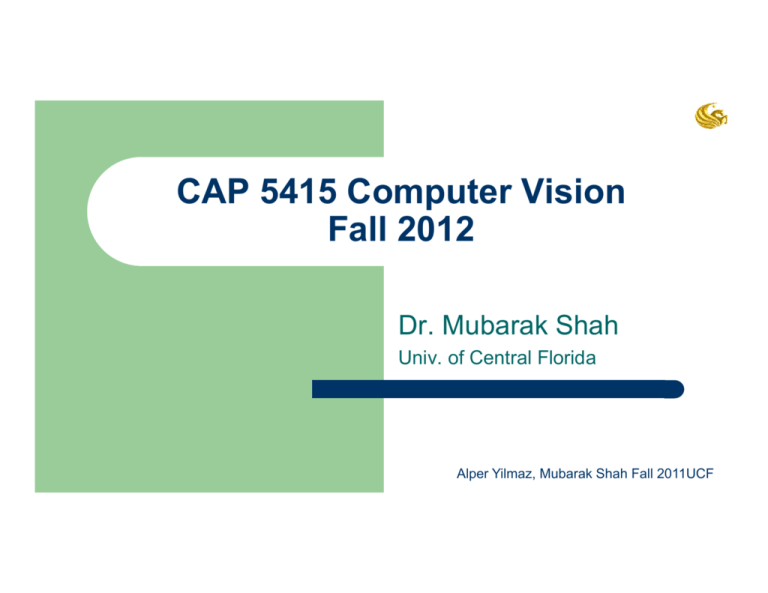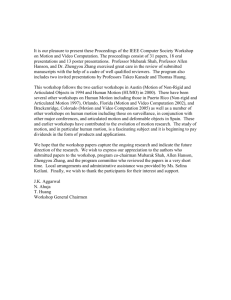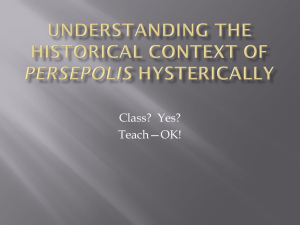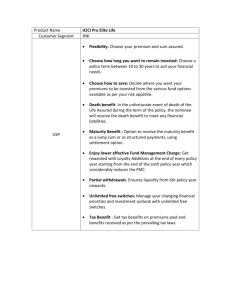CAP 5415 Computer Vision Fall 2012
advertisement

CAP 5415 Computer Vision
Fall 2012
Dr. Mubarak Shah
Univ. of Central Florida
Alper Yilmaz, Mubarak Shah Fall 2011UCF
Edge Detection
Lecture-3
Alper Yilmaz, Mubarak Shah Fall 2012UCF
Example
Alper Yilmaz, Mubarak Shah Fall 2012UCF
An Application
What is an object?
How can we find it?
Alper Yilmaz, Mubarak Shah Fall 2012UCF
Edge Detection in Images
At edges intensity or color changes
Alper Yilmaz, Mubarak Shah Fall 2012UCF
What is an Edge?
Discontinuity of intensities in the image
Edge models
–
–
–
–
Step
Roof
Ramp
Spike
Step
Ramp
Roof
Spike
Alper Yilmaz, Mubarak Shah Fall 2012UCF
Detecting Discontinuities
Image derivatives
f
f x f x
lim
0
x
Backward difference
[-1 1]
Central difference
[-1 0 1]
f x n 1 f x
f
x
x
Convolve
image with
derivative filters
Forward difference
[1 -1]
Alper Yilmaz, Mubarak Shah Fall 2012UCF
Derivative in Two-Dimensions
Definition
f x , y
f x , y f x , y
lim
0
x
f x , y f x
f x , y
Approximation
n 1
x
f x 1
m
x
1
Convolution kernels
n
, ym
f x , y
f x , y f x , y
lim
0
y
f x , y
f x n , y m 1 f x n , y m
y
x
1
fy
1
Alper Yilmaz, Mubarak Shah Fall 2012UCF
Image Derivatives
Image I
I x I * 1
1
1
Iy I *
1
Alper Yilmaz, Mubarak Shah Fall 2012UCF
Derivatives and Noise
Strongly affected by noise
–
obvious reason: image
noise results in pixels
that look very different
from their neighbors
The larger the noise is the
stronger the response
What is to be done?
–
–
–
Neighboring pixels look
alike
Pixel along an edge look
alike
Image smoothing should
help
Force pixels different to
their neighbors (possibly
noise) to look like
Alper Yilmaz, neighbors
Mubarak Shah Fall 2012UCF
Derivatives and Noise
Increasing noise
Zero mean additive gaussian noise
Alper Yilmaz, Mubarak Shah Fall 2012UCF
Image Smoothing
Expect pixels to “be like” their neighbors
–
Relatively few reflectance changes
Generally expect noise to be independent
from pixel to pixel
–
Smoothing suppresses noise
Alper Yilmaz, Mubarak Shah Fall 2012UCF
Gaussian Smoothing
(x2 y2
g ( x, y) e
2
2
Scale of Gaussian
–
–
–
As increases, more pixels are involved in average
As increases, image is more blurred
As increases, noise is more
effectively
Alper
Yilmaz, Mubaraksuppressed
Shah Fall 2012UCF
Gaussian Smoothing (Examples)
Alper Yilmaz, Mubarak Shah Fall 2012UCF
Edge Detectors
Gradient operators
–
–
Prewit
Sobel
Laplacian of Gaussian (Marr-Hildreth)
Gradient of Gaussian (Canny)
Alper Yilmaz, Mubarak Shah Fall 2012UCF
Prewitt and Sobel Edge Detector
Compute derivatives
–
In x and y directions
Find gradient magnitude
Threshold gradient magnitude
Alper Yilmaz, Mubarak Shah Fall 2012UCF
Prewitt Edge Detector
image
average
smoothing in x
1
1
1
1
1
1
image
1
1
derivative
filtering in x
1
1
and
average
smoothing in y
1
1
blurred
1
1
blurred
and
derivative
filtering in y
1
1
edges in x
1
1
1
1
1
1
0
0
0
edges in x
1
0
1
1
0
1
1
0
1
Alper Yilmaz, Mubarak Shah Fall 2012UCF
Sobel Edge Detector
*
1
2
1
1
2
1
0
0
0
d
I
dx
Image I
d
d
I
I
dx
dy
2
*
1
0
1
2
0
2
1
0
1
2
Threshold
Edges
d
I
dy
Alper Yilmaz, Mubarak Shah Fall 2012UCF
Sobel Edge Detector
d
I
dx
d
I
dy
Alper Yilmaz, Mubarak Shah Fall 2012UCF
Sobel Edge Detector
d
d
I
I
dx
dy
2
Threshold
2
100
Alper Yilmaz, Mubarak Shah Fall 2012, UCF
Marr Hildreth Edge Detector
Smooth image by Gaussian filter S
Apply Laplacian to S
–
Used in mechanics, electromagnetics, wave theory, quantum
mechanics and Laplace equation
Find zero crossings
–
–
Scan along each row, record an edge point at the location of
zero-crossing.
Repeat above step along each column
Marr Hildreth Edge Detector
Gaussian smoothing
smoothed
S
image
g
Gaussian
image
filter
*
I
g
1
e
2
x2 y2
2
2
Find Laplacian
second order
derivative
in x
2 S
2
S
x 2
second order
derivative
in y
2
S
y 2
• is used for gradient (derivative)
• is used for Laplacian
Alper Yilmaz, Mubarak Shah Fall 2012, UCF
Marr Hildreth Edge Detector
Deriving the Laplacian of Gaussian (LoG)
2 S 2 g * I 2 g * I
2 g
1
2
3
x2 y2
2
2
e
x2 y2
2
2
Alper Yilmaz, Mubarak Shah Fall 2012, UCF
Gaussian
x
g(x)
-3
-2
-1
0
1
2
3
.011
.13
.6
1
.6
.13
.011
Standard
deviation
2-D Gaussian
2-D Gaussian
LoG Filter
2G
1
2
3
x2 y2
2
2
e
x2 y2
2 2
Y
0.0008
0.0066
0.0215
0.031
0.0215
0.0066
0.0008
0.0066
0.0438
0.0982
0.108
0.0982
0.0438
0.0066
0.0215
0.0982
0
-0.242
0
0.0982
0.0215
0.031
0.108
-0.242
-0.7979
-0.242
0.108
0.031
0.0215
0.0982
0
-0.242
0
0.0982
0.0215
0.0066
0.0438
0.0982
0.108
0.0982
0.0438
0.0066
0.0008
0.0066
0.0215
0.031
0.0215
0.0066
0.0008
X
Alper Yilmaz, Mubarak Shah Fall 2012, UCF
Finding Zero Crossings
Four cases of zero-crossings :
–
–
–
–
{+,-}
{+,0,-}
{-,+}
{-,0,+}
Slope of zero-crossing {a, -b} is |a+b|.
To mark an edge
–
–
compute slope of zero-crossing
Apply a threshold to slope
Alper Yilmaz, Mubarak Shah Fall 2012, UCF
On the Separability of LoG
Similar to separability of Gaussian filter
–
Two-dimensional Gaussian can be separated into
2 one-dimensional Gaussians
h ( x, y ) I ( x, y ) * g ( x, y )
h ( x , y ) I ( x , y ) * g 1 ( x ) * g 2 ( y )
g (x) e
g1 g ( x ) .011
x2
2
2
.13
.6
n2 multiplications
2n multiplications
1
.6
.13
.011
.011
.13
.6
g 2 g ( y) 1
.6
.13
.011
Alper Yilmaz, Mubarak Shah Fall 2012, UCF
On the Separability of LoG
2 S 2 g * I 2 g * I I * 2 g
Requires n2 multiplications
2 S I g xx ( x ) g ( y ) I g yy ( y ) g ( x )
Requires 4n multiplications
Alper Yilmaz, Mubarak Shah Fall 2012, UCF
Seperability
Gaussian Filtering
Image
g(x)
g(y)
I g
Laplacian of Gaussian Filtering
gxx(x)
g(y)
Image
+
gyy(y)
2 S
g(x)
Alper Yilmaz, Mubarak Shah Fall 2012, UCF
Example
I
I * 2 g
Zero crossings
of 2 S
Alper Yilmaz, Mubarak Shah Fall 2012, UCF
Example
1
3
6
Alper Yilmaz, Mubarak Shah Fall 2012, UCF
Algorithm
Compute LoG
–
–
Use 2D filter
Use 4 1D filters
2 g ( x, y )
g ( x ), g xx ( x ), g ( y ), g
yy
( y)
Find zero-crossings from each row
Find slope of zero-crossings
Apply threshold to slope and mark edges
Alper Yilmaz, Mubarak Shah Fall 2012, UCF
Quality of an Edge
Robust to noise
Localization
Too many or too less responses
Alper Yilmaz, Mubarak Shah Fall 2012, UCF
Quality of an Edge
True
edge
Poor robustness
to noise
Poor
localization
Too many
responses
Alper Yilmaz, Mubarak Shah Fall 2012, UCF
Canny Edge Detector
Criterion 1: Good Detection: The optimal detector must
minimize the probability of false positives as well as false
negatives.
Criterion 2: Good Localization: The edges detected must
be as close as possible to the true edges.
Single Response Constraint: The detector must return
one point only for each edge point.
Alper Yilmaz, Mubarak Shah Fall 2012, UCF
Canny Edge Detector Steps
1.
2.
3.
4.
5.
Smooth image with Gaussian filter
Compute derivative of filtered image
Find magnitude and orientation of gradient
Apply “Non-maximum Suppression”
Apply “Hysteresis Threshold”
Alper Yilmaz, Mubarak Shah Fall 2012, UCF
Canny Edge Detector
First Two Steps
Smoothing
S I g ( x, y) g ( x, y) I
g ( x, y)
1
e
2
x2 y2
2
2
Derivative
S g I g I
gx I
gx
S
I
g I
g
y
y
g
g gx
y
gx
g
y
Alper Yilmaz, Mubarak Shah Fall 2012, UCF
Canny Edge Detector
Derivative of Gaussian
g x ( x, y)
g y ( x, y)
g ( x, y)
Alper Yilmaz, Mubarak Shah Fall 2012, UCF
Canny Edge Detector
First Two Steps
I
Sx
Sy
Alper Yilmaz, Mubarak Shah Fall 2012, UCF
Canny Edge Detector
Third Step
Gradient magnitude and gradient direction
( S x , S y ) Gradient
magnitude
direction
Vector
( S x2 S y2 )
tan
1
Sy
Sx
image
gradient magnitude
Alper Yilmaz, Mubarak Shah Fall 2012, UCF
Canny Edge Detector
Fourth Step
Non maximum suppression
We wish to mark points along the curve where the magnitude is largest. We can do this by
looking for a maximum along a slice normal to the curve (non-maximum suppression).
These points should form a curve. There are then two algorithmic issues: at which point is
the maximum, and where is the next one?
Alper Yilmaz, Mubarak Shah Fall 2012, UCF
Canny Edge Detector
Non-Maximum Suppression
Suppress the pixels in |S| which are not
local maximum
x , y
x , y
S x , y
M x , y
0
if S x , y S x , y
& S x , y S x , y
otherwise
x , y
x’ and x’’ are the neighbors of x along
normal direction to an edge
Alper Yilmaz, Mubarak Shah Fall 2012, UCF
Canny Edge Detector
Non-Maximum Suppression
S
S x2 S
2
y
M
For visual
ization
M Threshold
25
Alper Yilmaz, Mubarak Shah Fall 2012, UCF
Canny Edge Detector
Hysteresis Thresholding
If the gradient at a pixel is
–
–
–
above “High”, declare it as an ‘edge pixel’
below “Low”, declare it as a “non-edge-pixel”
between “low” and “high”
Consider its neighbors iteratively then declare it an
“edge pixel” if it is connected to an ‘edge pixel’ directly
or via pixels between “low” and “high”.
Alper Yilmaz, Mubarak Shah Fall 2012, UCF
Canny Edge Detector
Hysteresis Thresholding
Connectedness
x
x
x
4 connected
8 connected
6 connected
Alper Yilmaz, Mubarak Shah Fall 2012, UCF
Canny Edge Detector
Hysteresis Thresholding
Gradient
magnitude
High
low
Alper Yilmaz, Mubarak Shah Fall 2012, UCF
Canny Edge Detector
Hysteresis Thresholding
Scan the image from left to right, top-bottom.
–
–
The gradient magnitude at a pixel is above a high
threshold declare that as an edge point
Then recursively consider the neighbors of this
pixel.
If the gradient magnitude is above the low threshold
declare that as an edge pixel.
Alper Yilmaz, Mubarak Shah Fall 2012, UCF
Canny Edge Detector
Hysteresis Thresholding
M
regular
M 25
Hysteresis
High 35
Low 15
Alper Yilmaz, Mubarak Shah Fall 2012, UCF
Suggested Reading
Chapter 4, Emanuele Trucco, Alessandro
Verri, "Introductory Techniques for 3-D
Computer Vision"
Chapter 2, Mubarak Shah, “Fundamentals of
Computer Vision”
Alper Yilmaz, Mubarak Shah Fall 2012, UCF





